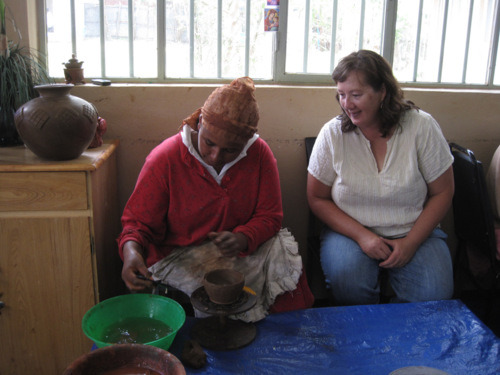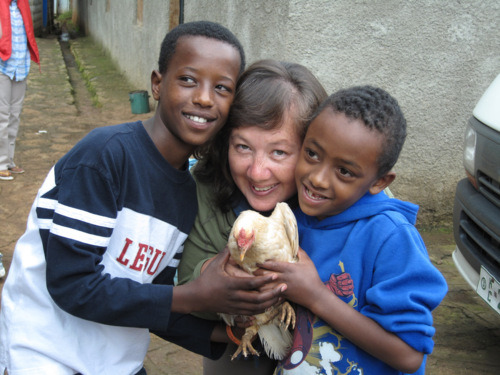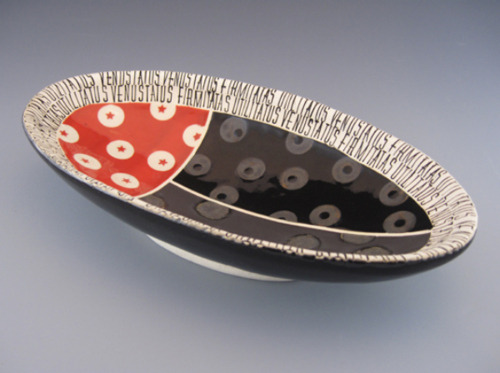
Text and pattern are seen everywhere in your works; they make a fantastic rhythm and enhance the forms. When did you start to use text on your works?
My current style using text started years ago when I was making mixed media sculptures that were mostly clay integrating text. I gave myself the challenge to make something esthetically pleasing. What I wanted to do was -to be able to tell a story with pots. I suddenly had the revelation of incorporating the text onto my pots. But it is very ironic that I use words on my work because I have always struggled with writing. And I still do! When I was working in sculpture, I only used single words, but now I have expanded to phrases.
You recently came home from Ethiopia. What did you experience there? Tell us your impressions.
My journey to Ethiopia started approximately four years ago, when my husband and I started the adoption process for our son Vander. In 2009, our permanent relationship with the country of Ethiopia started, we traveled to Addis Ababa, to pick up our son. As the days, months and years went by; I realized I wanted to give back to the country that gave us our son. I started looking for a way to go back to Ethiopia and volunteer. I went to Ethiopia this past July for three weeks. I worked with three organizations, One Child Campaign, Vision on Africa and Mission Ethiopia.
I worked with women to help restore their dignity who are HIV positive and who have leprosy, and women who are destitute. Through the language of clay, we were able to communicate, laugh and be with each other without a common language.
The women of Mission Ethiopia are HIV positive and suffer from leprosy; these women are considered outcasts and unemployable. Women like these and their children, spend their days searching the garbage dumps for food. Now, these women make pit fired beads, which are fired on the ground in an open fire. Currently they are able to feed their children and themselves.
I sat with the women much like an old fashioned quilting circle; they showed me how to roll the beads in my palm and decorate each bead. While we were making beads their children ran in, out and played outside with meager toys like old tires, but were always smiling.
Vision of Africa is an organization that is helping destitute women in many diverse ways, they provide medical care for mothers and children are educated on contraceptives, sponsorship programs of orphans, and of course they train women to be potters. Ceramics in Ethiopia is a very hands’ on process I was asked to help the women with their production process, but I felt like I learned more from them than they learned from me. Tigist, the master potter, gently guides the women from mixing the clay they collect from other regions of Ethiopia, to hand building bowls, vases, spice cellars, and coffee pots, and much more. While I was there, Tigist did a pit fire with me. I was amazed at her skill; she laid the green pots near the fire and slowly moved them into the fire ring. Then just like in American raku, she threw the pots in some dried leaves for a post reduction process.

“Me in Ethiopia with boys from one of the orphanages in Addis Ababa. I caught my frist chicken.”
I also worked with One Child Campaign; Caleb David runs orphan awareness trips to Ethiopia, and the trip immerses you into the life of the orphan and street children. I was on a team of 11 people we volunteered at several orphanages; we helped build an orphanage, put in flooring, painted, but most importantly we installed a water purification system.
My wonderful Ethiopian friends taught me that it doesn’t matter what our circumstances are, what our clothes look like, how full our bellies are, that we are all in this together, we all have the same emotions, loneliness, fear, joy and love.

Do you remember your first experience with ceramic art? When did you realize that this career was meant for you?
It was my last nine weeks of my senior year of high school, and I asked the ceramics teacher if I could start coming into her class during my off hour. I started going in and just fell in love with clay, soon I was coming in early in the morning, during lunch and after school. At this point, my parents had told me that, “I wouldn’t be one of those students who changed my major every semester.” So I announced that I was going to be an art major with a concentration in ceramics. And 30 years later I’m still working in clay!
And Yes, I do remember my first piece; my Mother still displays it in her house. It is a large coil built vessel stoneware vessel, with a Mishima design. I wish my Mom would hide it, but every time I see I am reminded where I started. And that I am thankful for my parents forcing me to focus on my lifetime goals that really have stuck.
From clear and objective, to soulful and funny, your messages vary a lot. How do you choose them?
The text for my pieces comes from everywhere. They are a path to look inward to decipher a glimpse into my private thoughts. They also can be snippets of conversation, mantras I repeat to myself, and partial stories of my life.
The vessel I made called This is How Much I Remember. This is How Much I Forgot, is about my Father’s early struggles with Alzheimer’s. As I watched, the disease get worse, and his memory fade. On the other hand, Gibberish is My New Language, is about being a new Mom and watching my son learn how to speak and communicate.

Plenty of Love, 2011, white earthenware, 12" x 5" x 5.“
Tell us about the process of constructing your pieces; what materials and techniques do you use?
I am a hand builder! I work almost solely in slab construction and glaze to cone 04 – 06. When I first set up my studio, I was really surprised how much I was spending on raw materials. I was disappointed how few glazes I could make with the glaze chemicals I bought. Instead of going into debt, I decided to see what my glazes would look like on Terra Cotta, using both clay bodies gives me two different looks with the same glaze.
All my forms are made with glazing in the forefront of my mind. Although every step of my process is extremely time consuming, the glazing takes the longest. When making my bowl forms I use coil built bisque molds for my slabs to set up on. I will usually make 5 or 6 at a time, so I’m not waiting for things to set up. When building all my pieces I like adding the text while the clay is fairly leather hard. But the pieces usually get leather hard, at the same time, and then I’m working fast and furious to keep up the drying process.
I always get asked how I get my glaze into the letters. It’s a very simple process, but I’m glad it looks difficult. I bisque my pieces, then I brush the glaze into the text and wipe it off with a sponge. Next, I let my pieces dry over night, and the taping process begins. I use masking tape and office supplies for all my glazing procedure. I tape off the text, and draw designs on to smooth bisque areas, and tape over it and cut out my designs with a Xacto knife.
This process is laid out in detail in the September – October 2011 Issue of Pottery Making Illustrated. Also, I have the article on my website and blog.

Take a Road Trip, 2010, earthenware, 17” x 6" x 2"
What motivates you as an artist? Where do you find the strength?
I am a mother of a very active four year, I have a full time job, and I am trying to pursue a career in ceramics in my free time. I do have down time from my studio, where I catch up on my sleep, and just hang out with my family. I long for the day when working in my studio is my 9 – 5 job. One way I make sure that I get back into my studio, is I apply for lots of shows to make sure I have deadlines. Deadlines are a fantastic motivator for me. Tim Rollins once said “It’s not passion, its panic.” With that said, I work in intense bursts. I am currently an art teacher at a junior high school where the students range from 12 to 15 years old. I feel that my students transformed my life of mediocrity into a life full of intensity and zeal.
My goal early in life was to become a rich and famous artist. This didn’t happen; I floundered through my youthful years right after graduating from college. I didn’t produce a piece of art. After ten years, of my feeble life as a cook, I stumbled into teaching; I started teaching adults two nights a week who wanted to learn pottery. I felt like a fraud. It had been years since I had even touched clay. The first few months I struggled making my hands remember what they had been so good at years before. One day, one of my students touched me in a way that changed my life forever. She stopped me at craft fair and critiqued the pottery. I realized I had taught her something. This tiny moment has shaped and formed my life; from this experience I discovered I loved teaching.
Now twelve years later, my junior high students affect me in this way every day. My role as an educator is to be an art cheerleader; I cheer to my students, adults, and colleagues alike. I teach as if this will be my student’s last and only year of art. I have to cover it all in such a short time. In this year, they will make art, write art, talk art; dream art and most of all appreciate art. Of course, I want my students to grow up and become rich and famous artists, but if they survive my “art boot camp” I know they will be lovers and appreciators of the arts. I believe my students have given me the most beautiful gift; they have awakened the power of creativity in me. With so much artistic potential in my classes, my students give me the energy to create and to be a working, professional artist.
Where can we find you and your works?
My work is represented by Plinth Gallery in Denver, Colorado, Crimson Laurel Gallery, Bakersville, North Carolina, and District Gallery, Park City, Utah.
Connie Norman was born in Japan, and raised all over the world. She is a graduate of the New York State College of Ceramics at Alfred University. She has also studied ceramics in Tokoname, Japan. Her work has been shown nationally and juried into many national shows, including Strictly Functional, Ceramics USA, Origins in Clay, and a solo exhibition at NCECA in 2006. Connie is a Robert Rauschenberg Foundation Fellowship recipient winner for 2002. Also, in 2005 she received a Wyoming Art Council Visual Art Fellowship.
By Vasi Hirdo.
Published in Ceramics Now Magazine Issue 1.
View Connie Norman’s profile on Ceramics Now.
Visit Connie Norman’s website and her blog.




















